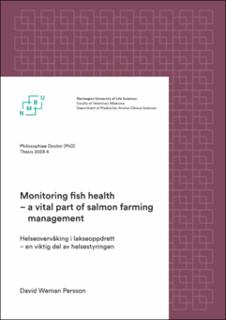| dc.contributor.advisor | Stormoen, Marit | |
| dc.contributor.advisor | Nødtvedt, Ane | |
| dc.contributor.advisor | Aunsmo, Arnfinn | |
| dc.contributor.advisor | Sørum, Henning | |
| dc.contributor.author | Persson, David Weman | |
| dc.date.accessioned | 2023-04-17T13:09:59Z | |
| dc.date.available | 2023-04-17T13:09:59Z | |
| dc.date.issued | 2023 | |
| dc.identifier.isbn | 978-82-575-1917-9 | |
| dc.identifier.issn | 1894-6402 | |
| dc.identifier.uri | https://hdl.handle.net/11250/3063384 | |
| dc.description.abstract | Mortality represents a major challenge in the salmon farming industry. In Norway
the mortality in the marine phase of the salmon production cycle has been 15-20%
annually the recent years. This situation is not sustainable for the fish, the farmers
or society. To prevent mortality throughout the production cycle, fish-groups at risk
of deteriorating health must be identified early, regarding both disease development
and stage in the production cycle. Hence, robust population health monitoring
methods are needed, which will provide farmers with information to make
knowledge-based decisions to improve fish health.
The aim of the thesis was to investigate monitoring methods that can be used to
improve fish health management in salmon farming. This was approached through
four studies investigating mortality patterns, cause-specific mortality classification,
gill mucous cell count and gill mucus microbial composition, respectively, as
potential factors relevant to monitoring fish health status in salmon farming.
Mortality patterns in salmon farming were investigated through a retrospective
study of fish-groups from two commercial fish farming companies, describing the
cause-specific mortality during the production cycle and investigating sources of
variation in mortality between the hatchery, marine farm, and the fish-group. Most
of the variation in mortality was attributed to the fish-group. Based on the
information from the cause-specific mortality registrations, smolt-related mortality
was found to be the major cause of death during the first six months of production,
while handling and treatment was the overall dominating cause of death in the full
production cycle. However, this varied extensively between the fish-groups.
The second study further explored the system of cause-specific mortality and
suggested a unique classification code. A system for classifying causes of mortality
based on underlying cause was created for salmon farming inspired by the human
mortality classification system. The proposed standard has a three-level hierarchical
structure of mortality causes. This accommodates different levels of details when
mortality causes are registered and enhance the information possible to retrieve
from the system.
To target early responses of the immune system, variation in gill mucous cell count
was studied as a potential method of monitoring health status. Salmon presmolt
from six commercial hatcheries was sampled and mucous cells were histologically
quantified based on certain criteria. The counts varied among both fish and farms.
When “farm” was included as an independent variable in a regression model the
proportion of variation in mucous cell counts explained by the model was twice as
high compared to when only fish size was included. This indicates that the variation
depends on farm-related factors.
A subset of the fish (from four recirculating aquaculture system (RAS) facilities)
included in the study of mucous cells was also sampled for gill mucus for microbial
composition analyses using 16S rRNA gene sequencing. Quantification of extracted
bacterial DNA in the gill mucus samples showed low levels in general, but fish from
one farm had considerably more bacterial DNA compared to the others. Samples
from the same farm were also compositionally different based on beta diversity
metrics, compared to the others as one group. Assessed by the Shannon index as an
outcome in a regression model, sources of variation attributed most variation to the
individual fish, suggesting gill microbial structure was linked to the individual fish.
No associations between gill microbial diversity and specific production parameters
were detected.
In conclusion, cause-specific mortality classification was found to identify important
causes of mortality in the production cycle, thus providing farmers with substantial
health information with limited effort and at little cost. The tool can further be
applied at desired level of detail and adapted to the needs of each farmer. Novel
methods of gill mucous cell count and microbial composition identifies variation
among farms and individual fish for the different measured parameters. This
variation can potentially be exploited to detect early signs of reduced health in the
fish. However, further studies are necessary to establish the causal association
between these factors and fish health before they can be used in systematic
monitoring of health in salmon farming. | en_US |
| dc.description.abstract | Dødelighet i oppdrettsnæringen er en stor utfordring i dag. Norsk lakseoppdrett har de siste årene hatt mellom 15 og 20% dødelighet i sjøfasen. Dette er ikke bærekraftig, hverken for fisken, oppdretterne eller samfunnet. For å forebygge dødelighet gjennom produksjonssyklusen må fiskegrupper som har økt risiko for dårligere helse identifiseres tidlig. Derfor er robuste overvåkingsmetoder på populasjonsnivå nødvendige, det vil gi oppdretterne nyttig informasjon for å kunne ta kunnskapsbaserte avgjørelser i arbeidet med å forbedre helsesituasjonen til fisken.
Målet med doktorgraden var å undersøke overvåkingsmetoder som kan brukes til å forbedre helsestyringen i oppdrettsnæringen. Dette ble gjort ved å undersøke mulige faktorer som kan gi informasjon om helsestatus, henholdsvis dødelighetsmønster, årsaks-spesifikk dødelighetsklassifisering, slimceller på gjellene og mikrobiell sammensetting på gjellenes slimlag. | en_US |
| dc.language.iso | eng | en_US |
| dc.publisher | Norwegian University of Life Sciences, Ås | en_US |
| dc.relation.ispartofseries | PhD Thesis;2023:4 | |
| dc.rights | Attribution-NoDerivatives 4.0 Internasjonal | * |
| dc.rights | Attribution-NonCommercial-NoDerivatives 4.0 Internasjonal | * |
| dc.rights.uri | http://creativecommons.org/licenses/by-nc-nd/4.0/deed.no | * |
| dc.subject | Fish health | en_US |
| dc.subject | Mortality classification | en_US |
| dc.subject | Sources of variation | en_US |
| dc.subject | Gill mucous cells | en_US |
| dc.subject | Gill microbial diversity | en_US |
| dc.title | Monitoring fish health : a vital part of salmon farming management | en_US |
| dc.title.alternative | Helseovervåking i lakseoppdrett : en viktig del av helsestyringen | en_US |
| dc.type | Doctoral thesis | en_US |

